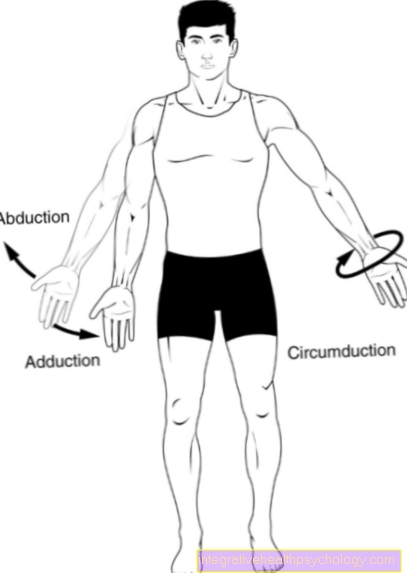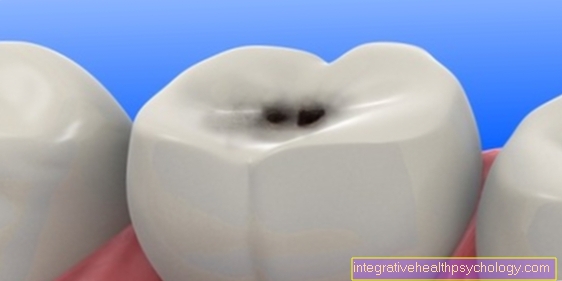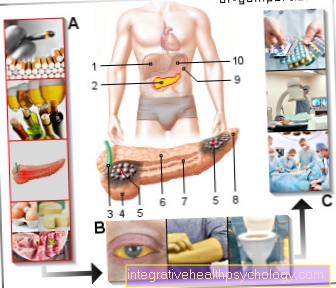Hepatitis A causes
Transmission of hepatitis A.
Hepatitis A is an inflammatory disease of the liver caused by the hepatitis A virus (HAV). The virus belongs to the group of Picornaviruses and is a small, uncovered one Single stranded RNA virusthat is highly resistant to the environment, so it can survive well even under poor conditions. This means that, for example, even extremely low temperatures cannot kill it or that the ability to survive in drought and water can be maintained for one to three months.

The transmission of the hepatitis A virus is referred to as fecal-oral, smear or contact infection. This also explains the most common routes of infection: Either it gets into the human body through food or water contaminated with feces or directly from person to person, for example if someone still has traces of feces on their hands and these come into contact with someone else.
For these reasons, hepatitis A can also be increasingly detected in countries with low hygiene standards and in places where there are many regular close contacts (such as in day-care centers). Food that is particularly often identified as a source of infection are mussels or other shellfish and crustaceans, but also vegetables or water. Transmission via the sexual route or via blood is possible in principle, but is rarely observed in practice .
Ultimately, the virus arrives in the intestine, from where it passes through the blood into the body's circulation and only affects liver cells. The exact mechanism that leads to the inflammatory reaction in the liver has not yet been fully clarified, but it is assumed that certain cytotoxic (thus causing cell death) Defense cells (Lymphocytes) are formed, which ultimately ensure that more liver cells die. This then ensures the typical symptoms of hepatitis, which result from the impaired functionality of the liver, in later stages especially jaundice (Jaundice).
Transmission through drinking water
Hepatitis A is caused by the hepatitis A virus. The pathogen is distributed worldwide. An infection can arise through direct transmission from person to person, but also through the consumption of contaminated food or contaminated water. This is often the case, especially in developing countries contaminated (i.e. contaminated) drinking water Transmission path for infections with the hepatitis A virus. The contamination of drinking water happens when hepatitis pathogens get into the wastewater and the drinking water is not subject to adequate purification standards. In order to avoid an infection in the respective countries, a hepatitis A vaccination should primarily be considered. For on-site prevention, it is advisable to boil drinking water for at least 5 minutes. Caution: Ice cubes are also a potential hepatitis A virus reservoir.
Read more on the topic: Vaccination against hepatitis A
Transmission through mussels and marine animals
Hepatitis A outbreaks in certain countries are primarily caused by contaminated water or food. Above all, mussels and marine animals should be mentioned here. Because they have their habitat in water, polluted water can lead to the transmission of the pathogens to marine animals. After eating infected mussels and marine animals, humans can be infected with hepatitis A. A safe killing of the pathogens is not guaranteed by briefly boiling or grilling the seafood. Infected seafood does not only play a role in developing countries. There is also a risk of contamination in the coastal regions of countries like Italy. Therefore, their consumption should be avoided or it should be ensured that sufficient cooking has taken place.
Transmission by blood
Blood transmission of hepatitis A is not typical. Much more often, transmission occurs through direct interpersonal contact such as sexual intercourse (especially sexual intercourse between men) or through contaminated food. According to the Robert Koch Institute, however, transmissions via the bloodstream have been described in some cases. The transmission can take place here, for example, through insufficiently controlled blood products or through the use of the same syringe set when consuming drugs. In order for such an infection to be possible via the bloodstream, however, the infected person must be in a certain phase of the disease, during which the hepatitis viruses are just in sufficient numbers in the bloodstream. Infection via the bloodstream is rather rare in hepatitis A.
Can I Get Infected From Kissing?
Hepatitis A is not a disease that can be transmitted through pure kissing. Nonetheless, caution is advised in the case of very close intimate contact. The infection can occur fecal-oral route happen. This means that traces of faecal excretion of the infected person can lead to an infection of another person if the latter ingests these traces via the mouth. This can be the case, for example, in the event of poor intimate hygiene or special sex practices. A simple (tongue) kiss is not included here. The Robert Koch Institute recommends vaccination against hepatitis A for all people with sexual behavior with a high risk of infection. Homosexual men, for example, belong to the risk group.
Can it be transmitted during pregnancy?
Infection with the hepatitis A virus is just as possible during pregnancy as in non-pregnant women. However, the infection is potentially much more dangerous during pregnancy and should therefore be avoided at all costs. This has to do with the fact that the infection can in principle be transmitted to the unborn child. This increases the risk of premature birth or even worse complications for the unborn child. A vaccination against hepatitis A is also possible during pregnancy and should always be given when traveling to areas with a high hepatitis A infection rate.























.jpg)





